What do you mean? It's been the same forever, Radeons do relatively better the higher res it isSomething odd is going on in 4K…
Install the app
How to install the app on iOS
Follow along with the video below to see how to install our site as a web app on your home screen.
Note: This feature may not be available in some browsers.
You are using an out of date browser. It may not display this or other websites correctly.
You should upgrade or use an alternative browser.
You should upgrade or use an alternative browser.
No DX12 Software is Suitable for Benchmarking *spawn*
- Thread starter trinibwoy
- Start date
DavidGraham
Veteran
More Halo Wars 2 DX12:
http://www.benchmark.pl/testy_i_rec...wydajnosci-kart-graficznych/strona/27592.html

http://www.benchmark.pl/testy_i_rec...wydajnosci-kart-graficznych/strona/27592.html

DavidGraham
Veteran
Alessio1989
Regular
Interesting, finally AAA devs are beginning to lower the GPU overhead, and without SM6... But all those benchmarks are still made with recent and good CPUs.. Maybe it's time to see how much older CPUs (nahlem/sandy bridge/ivy bridge/phenom1&2) can achieve some benefits from running those games in "DirectX12 mode"...
DavidGraham
Veteran
More developers comments on DX12, Nixxes (Tomb Raider, Deus Ex) is arguing that -right now- DX12 is not what it is cranked up to be.
DirectX 12 is designed to improve performance is by distributing rendering overhead evenly among many CPU cores, in a multi-core CPU. For high-performance desktop users with reasonably fast CPUs, the gains are negligible. This also goes for people gaming on higher resolutions, such as 1440p and 4K Ultra HD, where the frame-rates are low, and the performance tends to be more GPU-limited.
Asynchronous Compute. There have been examples of games that take advantage of gaining more performance out of a certain brand of GPU than the other, and this is a problem, according to developers. Hardware support to async compute is limited to only the latest GPU architectures, and requires further tuning specific to the hardware. Performance gains seen on closed ecosystems such as consoles, hence, don't necessarily come over to the PC.
The idea behind new-generation "close-to-the-metal" APIs such as DirectX 12 and Vulkan, has been to make graphics drivers as less relevant to the rendering pipeline as possible. The speakers contend that the drivers are still very relevant, and instead, with the advent of the new APIs, their complexities have further gone up, in the areas of memory management, manual multi-GPU (custom, non-AFR multi-GPU implementations), the underlying tech required to enable async compute, and the various performance-enhancement tricks the various driver vendors implement to make their brand of hardware faster, which in turn can mean uncertainties for the developer in cases where the driver overrides certain techniques, just to squeeze out a little bit of extra performance.
Memory management is the hardest part about DirectX 12, but the developer community is ready to embrace the innovation (such as mega-textures, tiled-resources, etc).
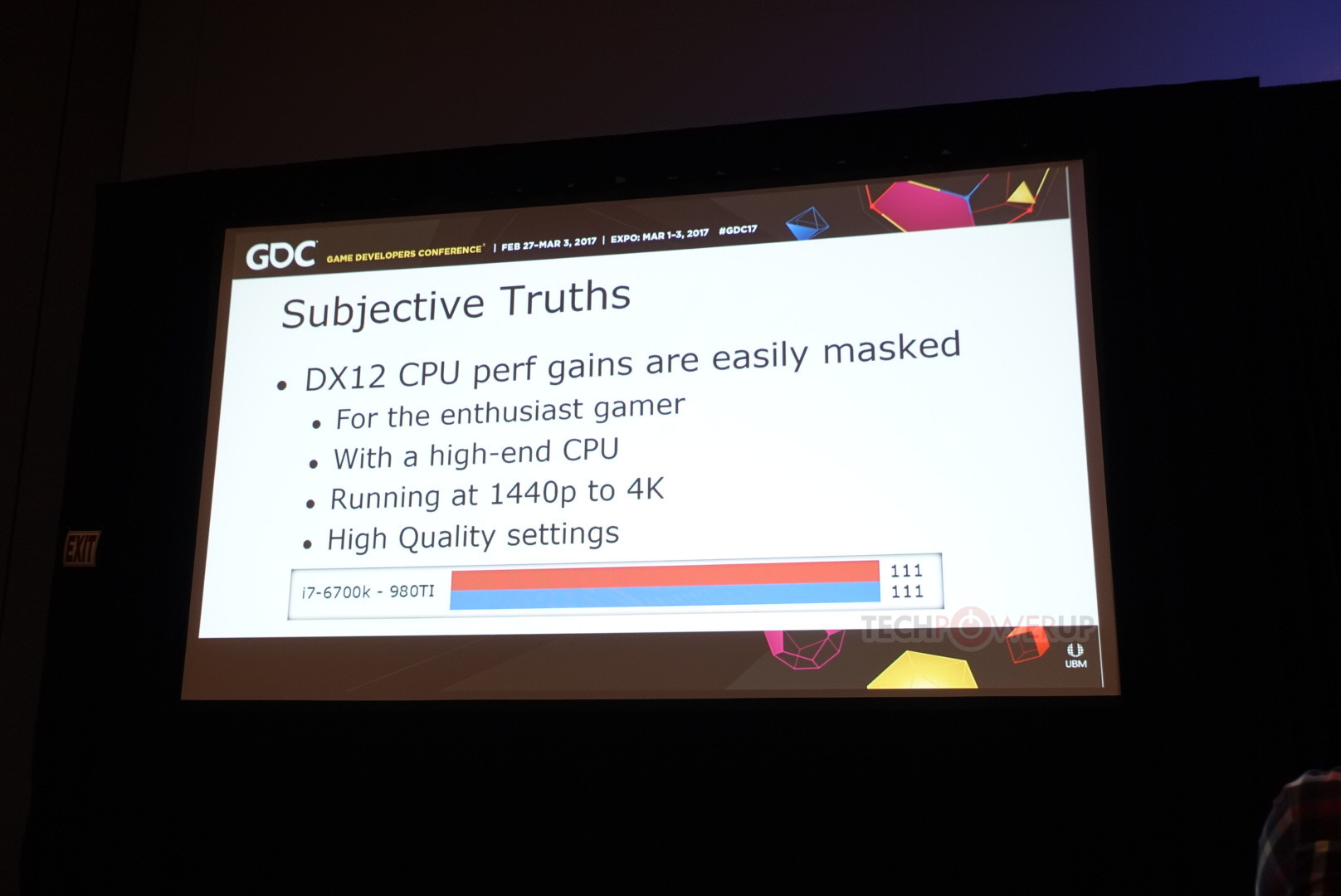
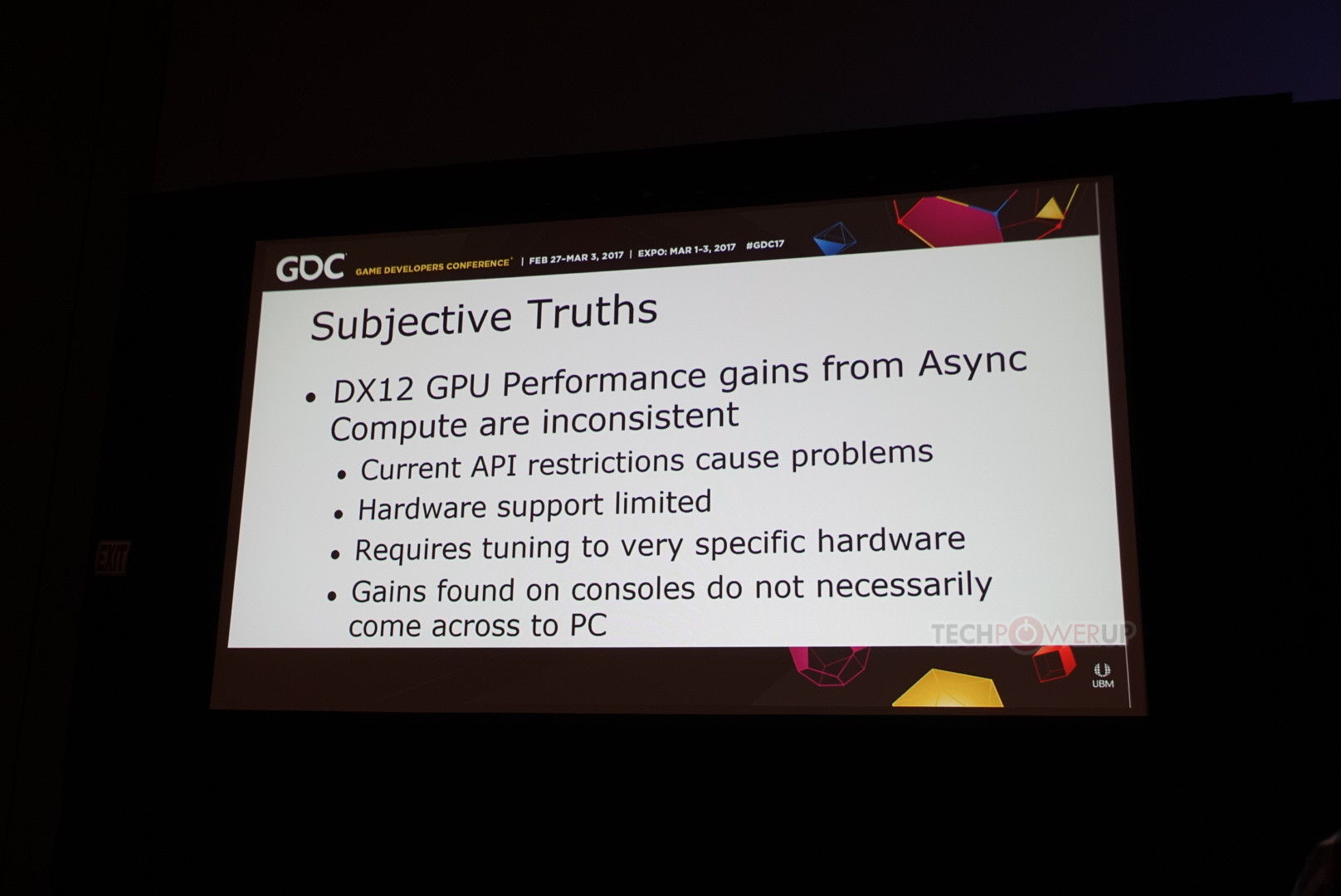
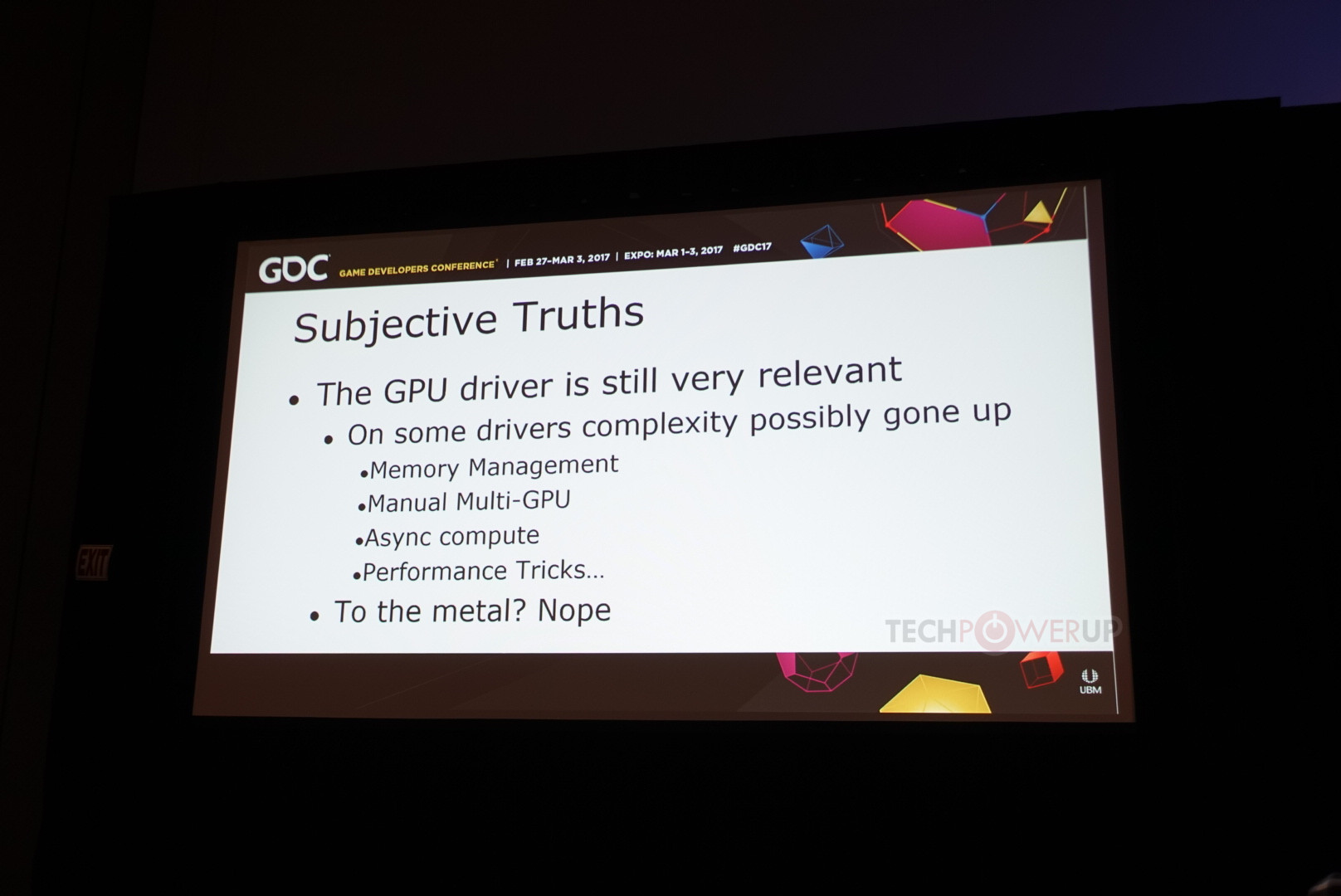
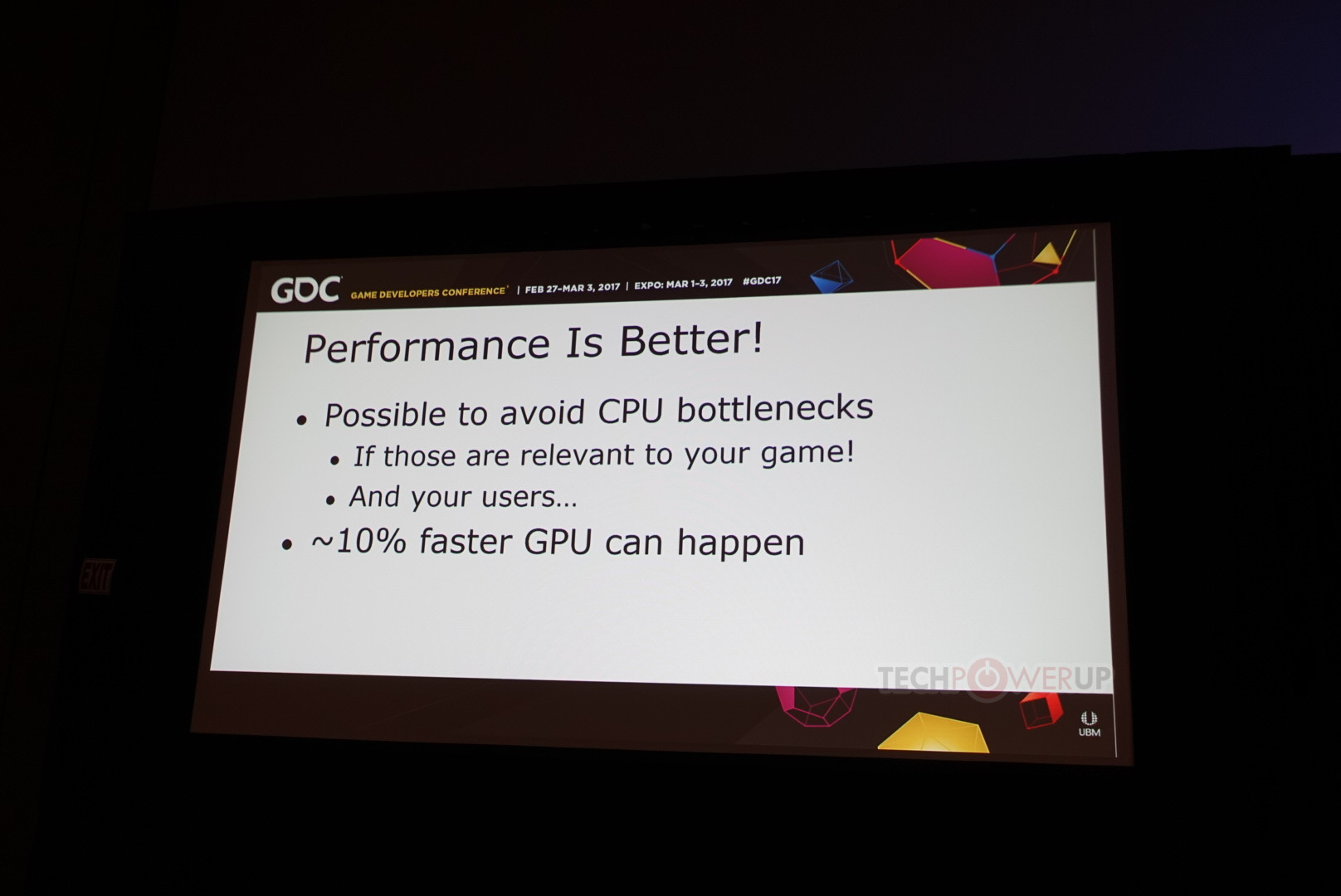
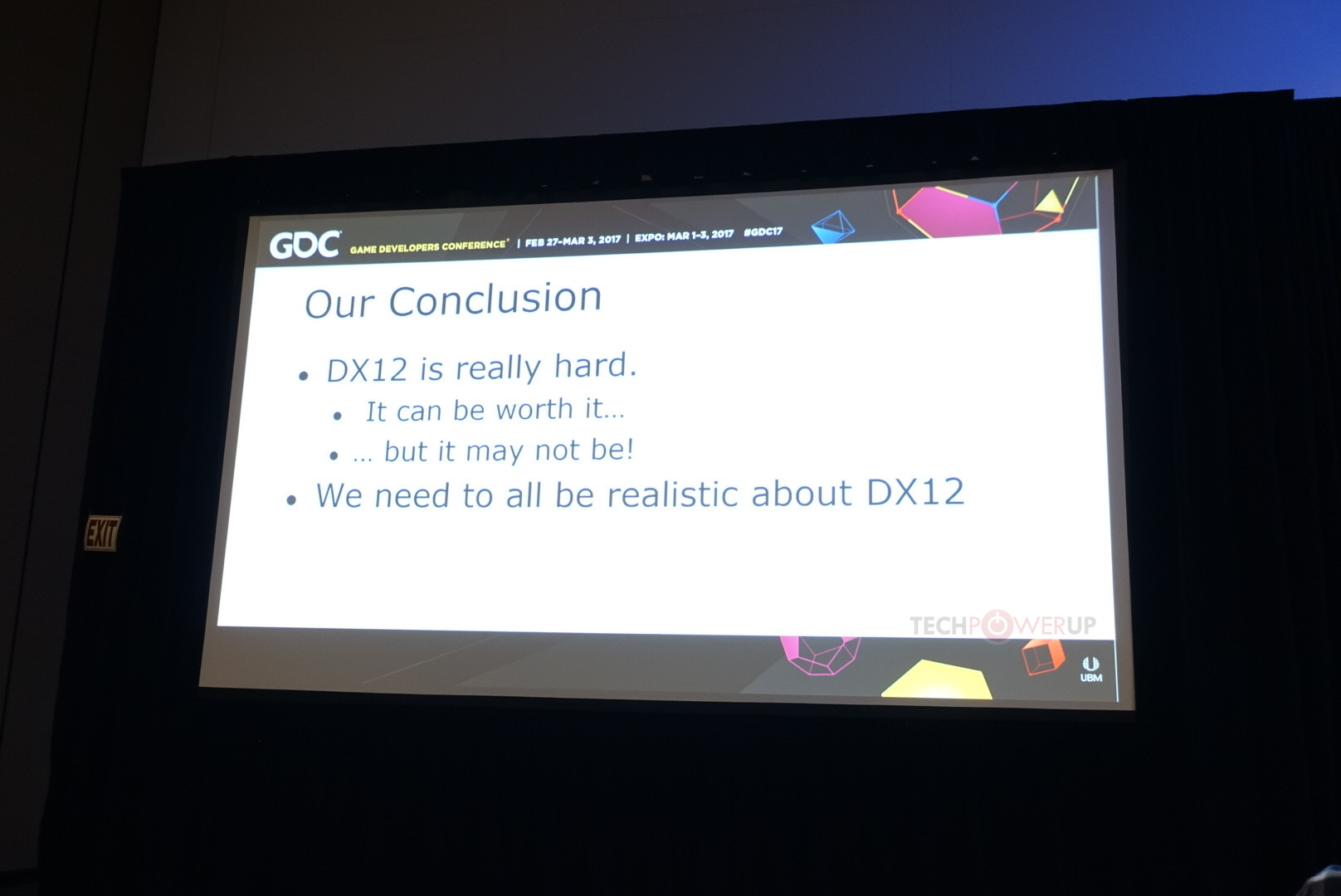
https://www.techpowerup.com/231079/is-directx-12-worth-the-trouble
DirectX 12 is designed to improve performance is by distributing rendering overhead evenly among many CPU cores, in a multi-core CPU. For high-performance desktop users with reasonably fast CPUs, the gains are negligible. This also goes for people gaming on higher resolutions, such as 1440p and 4K Ultra HD, where the frame-rates are low, and the performance tends to be more GPU-limited.
Asynchronous Compute. There have been examples of games that take advantage of gaining more performance out of a certain brand of GPU than the other, and this is a problem, according to developers. Hardware support to async compute is limited to only the latest GPU architectures, and requires further tuning specific to the hardware. Performance gains seen on closed ecosystems such as consoles, hence, don't necessarily come over to the PC.
The idea behind new-generation "close-to-the-metal" APIs such as DirectX 12 and Vulkan, has been to make graphics drivers as less relevant to the rendering pipeline as possible. The speakers contend that the drivers are still very relevant, and instead, with the advent of the new APIs, their complexities have further gone up, in the areas of memory management, manual multi-GPU (custom, non-AFR multi-GPU implementations), the underlying tech required to enable async compute, and the various performance-enhancement tricks the various driver vendors implement to make their brand of hardware faster, which in turn can mean uncertainties for the developer in cases where the driver overrides certain techniques, just to squeeze out a little bit of extra performance.
Memory management is the hardest part about DirectX 12, but the developer community is ready to embrace the innovation (such as mega-textures, tiled-resources, etc).





https://www.techpowerup.com/231079/is-directx-12-worth-the-trouble
Not to me.Is this any surprise?
I thought from the start they said that it's harder on the devs, one architecture performing better than another for some operations errrrr yea and expected for async compute for the time being.
Can't wait to read the link to see what else is said, but on the surface it's pretty much as expected.
Guess it's still useful to get it all out there, again...
D
Deleted member 2197
Guest
The idea behind new-generation "close-to-the-metal" APIs such as DirectX 12 and Vulkan, has been to make graphics drivers as less relevant to the rendering pipeline as possible. The speakers contend that the drivers are still very relevant, and instead, with the advent of the new APIs, their complexities have further gone up, in the areas of memory management, manual multi-GPU (custom, non-AFR multi-GPU implementations), the underlying tech required to enable async compute, and the various performance-enhancement tricks the various driver vendors implement to make their brand of hardware faster, which in turn can mean uncertainties for the developer in cases where the driver overrides certain techniques, just to squeeze out a little bit of extra performance.
So, instead of being easier to develop games it's become more difficult under the new "close to the metal" api's.
Anarchist4000
Veteran
More like there are a few cases lacking metal to code towards. It works but some hardware is a PITA currently. Phase that hardware out and DX12 is the future. Case in point the one specific card representing a chunk of the market they mentioned.So, instead of being easier to develop games it's become more difficult under the new "close to the metal" api's.
DavidGraham
Veteran
It is to some, many people have contended most of these points before, whether it was wishful thinking, blind bias, or something else, the results are the same.Is this any surprise?
Vulkan case is a bit different with it's added vendor specific extensions that can give large performance gains, it's also widely supported (on all versions of Windows) and on so many GPUs (without ridiculous feature levels restrictions).I wonder to what extent this holds for Vulkan.
You have two kinds of API, D3D11/OpenGL are fast and inexpensive, while D3D12/Vulkan are very fast but expensive.
And yes if the API is too level, hardware too different or abstraction (because you still need some until all GPU share an ISA) is not good enough, you'll have to code hardware specific code, which is expensive and annoying, and wasteful.
And yes if the API is too level, hardware too different or abstraction (because you still need some until all GPU share an ISA) is not good enough, you'll have to code hardware specific code, which is expensive and annoying, and wasteful.
D
Deleted member 2197
Guest
NVIDIA Readies GeForce DirectX 12 Driver, 16% Average Performance Uplift – Aimed at Entire GeForce 10 Lineup Including GeForce GTX 1080 Ti
http://wccftech.com/nvidia-geforce-...ascal/?utm_source=wccftech&utm_medium=relatedNVIDIA has announced that they will be releasing a new GeForce driver aimed to improve DirectX 12 GPU performance and deliver more feature goodness to their gaming fans. The news comes just hours after NVIDIA announced the fastest graphics card on the planet...
The new Game Ready DirectX 12 driver will be known as the GeForce 378.74. Performance results posted over at Videocardz reveal that we are looking at some huge gains.
NVIDIA has not confirmed when this new DX12 driver will be available, but a good guess would be close to 1080 Ti launch.
NVIDIA Readies GeForce DirectX 12 Driver, 16% Average Performance Uplift – Aimed at Entire GeForce 10 Lineup Including GeForce GTX 1080 Ti
http://wccftech.com/nvidia-geforce-...ascal/?utm_source=wccftech&utm_medium=related
The same marketing spin as with most driver announcements.
These are improvements over a quite old driver revision, not 16 miraculous % more perf over the last driver. And much of it is because of regular optimizations for newly launched titles. It's more a track record where they came from over time since mid-2016 when the 368 driver came out.
D
Deleted member 2197
Guest
Should be just a few days till we know, but assume any difference may only be DX12 related. This is the first driver in a long time with stated performance deltas, otherwise it's just been bug fixes and new game profiles.
DavidGraham
Veteran
In a somewhat harsh statement: UbiSoft says:
Don’t develop on DirectX 12 just chasing performance gains
However not all is bad, some pros can still be attainable:
Don’t develop on DirectX 12 just chasing performance gains
Turns out that just hitting the same gaming performance Ubisoft were getting on the DirectX 11 version of AnvilNext alone was hard enough when switching over to DX12. They seem to think you should be super-happy if your game can match the old API’s performance, never mind deliver some magical performance gains.
If you take the narrow view that you only care about raw performance you probably won’t be that satisfied with amount of resources and effort it takes to even get to performance parity with DX11
Ubisoft have only seen a GPU performance boost of around 5% at best, and that’s mostly down to the better initial async compute prowess of AMD’s latest graphics tech. The CPU performance scales better, in their experience delivering between 15-30% improved processor performance. Though that’s still not necessarily going to translate into hefty FPS gains in-game.
However not all is bad, some pros can still be attainable:
For feature set, we are now pretty much at feature-parity on PC. Which is great from an engine design perspective,” said Rodrigues. “‘You can, more or less, unify the feature set with the consoles and you have the opportunity to do some positive architectural changes to your engine.
https://www.pcgamesn.com/microsoft/ubisoft-dx12-performanceBut it’s not all about the consoles and DirectX 12 though. One of the benefits of porting your game or your engine over to DirectX 12 is that all the ‘grunt work’ will then have been done if you want to then move on to another low-level API such as Vulkan.
Similar threads
- Replies
- 13
- Views
- 6K
- Replies
- 91
- Views
- 20K
- Replies
- 98
- Views
- 36K



